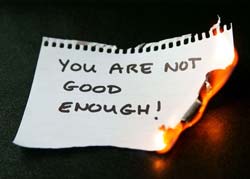
Self-doubt can crush you and it will if you get caught in it.
- “You’re not good enough.”
- “You don’t have what it takes to succeed.”
- “No one will read your stuff.”
- “You should just give it up.”
For some of us the criticism we spit at ourselves is the background track that plays in our heads 24/7. You can’t turn it off or mute it. Sing along, “You aren’t good enough. What’s the point?”

This is just another form of excusing why you aren’t writing. “I can’t write because my muse has left for the day.” “I have so many other things to do.” “The laundry is backing up and I need to give the dog a bath.” Or, maybe you are one of those who overindulge.

It waited this long.
Historically, many writers have had issues with alcohol and other addictions. These are other forms of the anti-success story. Okay, scary, I know. But even this can be defeated. You can learn how to mute the inner voice. Let’s face our saboteurs and shove them aside.

Oooo, I can almost hear angels singing. LOL. Okay, I am a bit scared. You? Okay, we can do this. Get your copy of Around the Writer’s Block by Rosanne Bane and jump over to page 177. Fill your cuppa with something that comforts you, like cocoa or tea. Grab a nibble, make it a healthy one cuz we are trying to clear our minds here. All right let’s tuck in and start the journey.

Inner critic -vs- Saboteur. Yes, they can be one and the same. Or not. Confused? Me too. Okay, so there are two types of Inner Critic: the discerning critic and the damaging critic (the Saboteur). The discerning critic takes the writing and appreciates what it is and what it can become. They are willing to see beyond the imperfections and make effective changes to improve the tale being told. Whereas, the saboteur makes judgements at the jump. They make sweeping generalizations that damn the writing and the writer. They never see the underlying potential.
We all have this demon on our shoulders. The saboteur is always close. It is actually ingrained in our brains. The left hemisphere is the origin of negative thought patterns, jealousy, rage, and fear. The house of destructive behavior. The location is the size of a peanut but can massively impact your life.
Turning your tale into a success story.

In the book, Ms. Bane speaks of a fellow author who had major issues with her saboteur. What she did amuses me and yet I want to try it. She bought a toy, an image to connect to her negative critic. It is suggested that you make it something you can have compassion for, something cute and cuddly. When your inner jerk pops its head up and starts talking badly about you and your work, you simply look at this physical manifestation and tell it to, “Shhh.” Treating like a baby or a misbehaving toddler. You treat it gently but with conviction. Train your little monster, or inner voice, that it is not nice to talk bad about ourselves.
It is vital that we begin developing ways to cope with our little nasty voice. We wouldn’t let a person speak that way about us. Why do we allow ourselves to do it? Don’t let that little monster make a list of regrets you have on your deathbed. Tell it to “shhh,” and keep going. Eventually it will become easier. I am not going to say it will go away, it won’t. As the book explained, it is part of our brain’s make up. But we can control how long it has a voice.

Meet Negative Nancy. She is my physical representative of all the nasty things I say about myself and my work. She is cute and cuddly and being quieted by compassion for her and myself. “Shhh, Nancy. I have work to do.”



